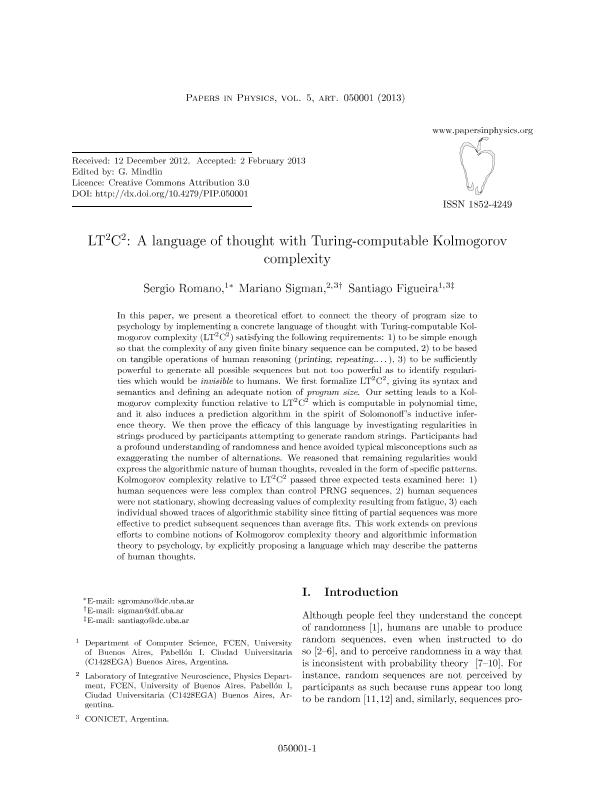Mostrar el registro sencillo del ítem
dc.contributor.author
Romano, Sergio Gaston

dc.contributor.author
Sigman, Mariano

dc.contributor.author
Figueira, Santiago

dc.date.available
2015-10-02T20:20:18Z
dc.date.issued
2013-02-02
dc.identifier.citation
Romano, Sergio Gaston; Sigman, Mariano; Figueira, Santiago; LT2C2: A language of thought with Turing-computable Kolmogorov complexity; Instituto de Física de Líquidos y Sistemas Biológicos; Papers in Physics; 5; 2-2-2013; 1-14
dc.identifier.issn
1852-4249
dc.identifier.uri
http://hdl.handle.net/11336/2296
dc.description.abstract
In this paper, we present a theoretical effort to connect the theory of program size to psychology by implementing a concrete language of thought with Turing-computable Kolmogorov complexity ( ) satisfying the following requirements: 1) to be simple enough so that the complexity of any given finite binary sequence can be computed, 2) to be based on tangible operations of human reasoning (printing, repeating,. . . ), 3) to be sufficiently powerful to generate all possible sequences but not too powerful as to identify regularities which would be invisible to humans. We first formalize , giving its syntax and semantics, and defining an adequate notion of program size. Our setting leads to a Kolmogorov complexity function relative to which is computable in polynomial time, and it also induces a prediction algorithm in the spirit of Solomonoff’s inductive inference theory. We then prove the efficacy of this language by investigating regularities in strings produced by participants attempting to generate random strings. Participants had a profound understanding of randomness and hence avoided typical misconceptions such as exaggerating the number of alternations. We reasoned that remaining regularities would express the algorithmic nature of human thoughts, revealed in the form of specific patterns. Kolmogorov complexity relative to passed three expected tests examined here: 1) human sequences were less complex than control PRNG sequences, 2) human sequences were not stationary showing decreasing values of complexity resulting from fatigue 3) each individual showed traces of algorithmic stability since fitting of partial data was more effective to predict subsequent data than average fits. This work extends on previous efforts to combine notions of Kolmogorov complexity theory and algorithmic information theory to psychology, by explicitly proposing a language which may describe the patterns of human thoughts.
dc.format
application/pdf
dc.language.iso
eng
dc.publisher
Instituto de Física de Líquidos y Sistemas Biológicos
dc.rights
info:eu-repo/semantics/openAccess
dc.rights.uri
https://creativecommons.org/licenses/by/2.5/ar/
dc.subject
Complexity
dc.subject
Psychology
dc.subject.classification
Ciencias de la Computación

dc.subject.classification
Ciencias de la Computación e Información

dc.subject.classification
CIENCIAS NATURALES Y EXACTAS

dc.subject.classification
Psicología

dc.subject.classification
Psicología

dc.subject.classification
CIENCIAS SOCIALES

dc.title
LT2C2: A language of thought with Turing-computable Kolmogorov complexity
dc.type
info:eu-repo/semantics/article
dc.type
info:ar-repo/semantics/artículo
dc.type
info:eu-repo/semantics/publishedVersion
dc.date.updated
2016-03-30 10:35:44.97925-03
dc.journal.volume
5
dc.journal.pagination
1-14
dc.journal.pais
Argentina

dc.journal.ciudad
La Plata
dc.description.fil
Fil: Romano, Sergio Gaston. Universidad de Buenos Aires. Facultad de Ciencias Exactas y Naturales. Departamento de Computación; Argentina. Consejo Nacional de Investigaciones Científicas y Técnicas; Argentina
dc.description.fil
Fil: Sigman, Mariano. Consejo Nacional de Investigaciones Científicas y Técnicas. Oficina de Coordinación Administrativa Ciudad Universitaria. Instituto de Física de Buenos Aires; Argentina. Universidad de Buenos Aires. Facultad de Ciencias Exactas y Naturales. Departamento de Física. Laboratorio de Neurociencia Integrativa; Argentina
dc.description.fil
Fil: Figueira, Santiago. Universidad de Buenos Aires. Facultad de Ciencias Exactas y Naturales. Departamento de Computación; Argentina. Consejo Nacional de Investigaciones Científicas y Técnicas; Argentina
dc.journal.title
Papers in Physics
dc.relation.alternativeid
info:eu-repo/semantics/altIdentifier/doi/http://dx.doi.org/10.4279/PIP.050001
dc.relation.alternativeid
info:eu-repo/semantics/altIdentifier/url/http://arxiv.org/abs/1303.0875
dc.relation.alternativeid
info:eu-repo/semantics/altIdentifier/url/http://neuro.org.ar/es/node/161
dc.relation.alternativeid
info:eu-repo/semantics/altIdentifier/url/http://www.papersinphysics.org/index.php/papersinphysics/article/view/128
Archivos asociados
